PAC-12 Conference


The Pac-12 Conference is a collegiate athletic conference that operates in the Western United States, participating in 24 sports at the NCAA Division I level. Its football teams compete in the Football Bowl Subdivision (FBS; formerly Division I-A), the higher of two tiers of NCAA Division I football competition.
The conference's 12 members are located in the states of Arizona, California, Colorado, Oregon, Utah, and Washington. They include each state's flagship public university, four additional public universities, and two private research universities.
The modern Pac-12 conference formed after the disbanding of the Pacific Coast Conference (PCC), whose principal members founded the Athletic Association of Western Universities (AAWU) in 1959. The conference previously went by the names Big Five, Big Six, Pacific-8, and Pacific-10. The Pac-12 moniker was adopted in 2011 with the addition of Colorado and Utah.
Nicknamed the "Conference of Champions", the Pac-12 has won more NCAA national championships in team sports than any other conference in history. The top three schools with the most NCAA team championships are members of the Pac-12: Stanford, UCLA, and USC, in that order. Washington's national title in women's rowing in 2017 was the 500th NCAA championship won by a Pac-12 school.
University of Arizona
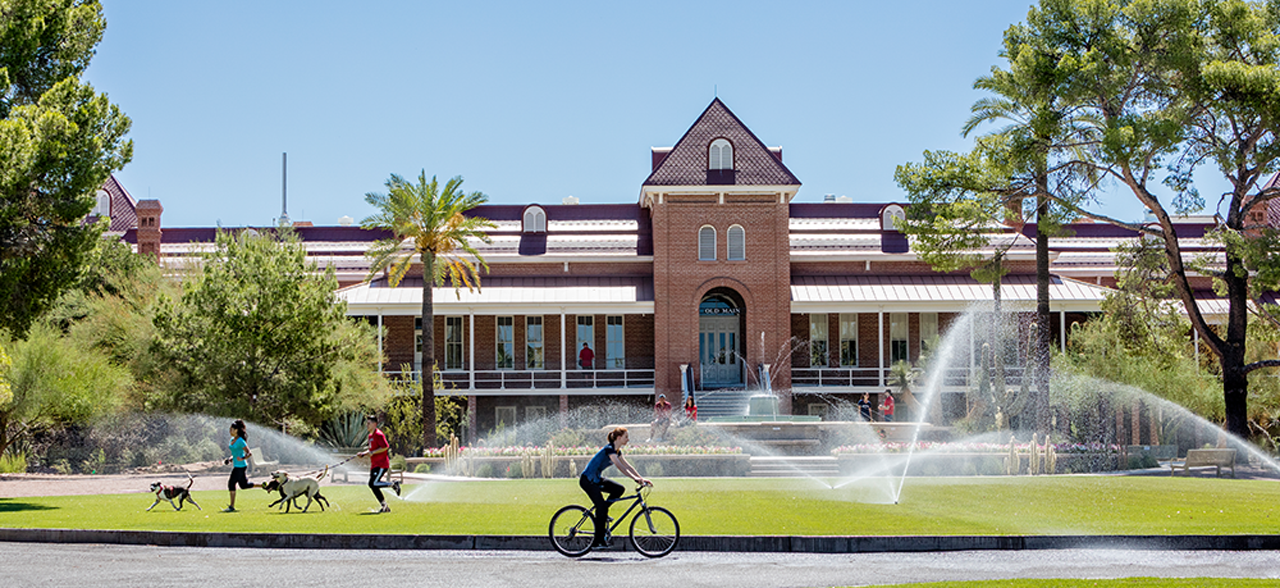
The University of Arizona (also referred to as U of A, UA, or Arizona) is a public research university in Tucson, Arizona. Founded in 1885, the UA was the first university in the Arizona Territory. As of 2016, the university enrolls 43,625 students in 19 separate colleges/schools, including the University of Arizona College of Medicine in Tucson and Phoenix and the James E. Rogers College of Law, and is affiliated with two academic medical centers (Banner - University Medical Center Tucson and Banner - University Medical Center Phoenix). The University of Arizona is governed by the Arizona Board of Regents. The University of Arizona is one of the elected members of the Association of American Universities (an organization of North America's premier research institutions) and is the only representative from the state of Arizona to this group.
Known as the Arizona Wildcats (often shortened to "Cats"), the athletic teams are members of the Pac-12 Conference of the NCAA. UA athletes have won national titles in several sports, most notably men's basketball, baseball, and softball. The official colors of the university and its athletic teams are cardinal red and navy blue.
Washington State University

Founded in 1890, WSU (colloquially "Wazzu") is a land-grant university with programs in chemical engineering, veterinary medicine, agriculture, pharmacy, neuroscience, food science, plant science, mathematics, business, architecture, and communications. It is ranked in the top 140 universities in America with high research activity, as determined by U.S. News & World Report. With an undergraduate enrollment of 24,470 and a total enrollment of 29,686, it is the second largest institution of higher education in Washington state behind the University of Washington.
The university also operates campuses across Washington known as WSU Spokane, WSU Tri-Cities, and WSU Vancouver, all founded in 1989. In 2012, WSU launched an Internet-based Global Campus, which includes its online degree program, WSU Online. These campuses award primarily bachelor's and master's degrees. Freshmen and sophomores were first admitted to the Vancouver campus in 2006 and to the Tri-Cities campus in 2007. Enrollment for the four campuses and WSU Online exceeds 29,686 students. This includes 1,751 international students.
WSU's athletic teams are called the Cougars and the school colors are crimson and gray. Six men's and nine women's varsity teams compete in NCAA Division I in the Pac-12 Conference. Both men's and women's indoor track teams compete in the Mountain Pacific Sports Federation.
Arizona State University

Arizona State University (commonly referred to as ASU or Arizona State) is a public metropolitan research university on five campuses across the Phoenix metropolitan area, and four regional learning centers throughout Arizona. The 2018 university ratings by U.S. News & World Report rank ASU No. 1 among the Most Innovative Schools in America for the third year in a row and has ranked ASU No. 115 in National Universities with overall score of 47/100 with 83% of student applications accepted.
ASU is one of the largest public universities by enrollment in the U.S. It had approximately 72,000 students enrolled in fall 2017, including 59,198 undergraduate and 12,630 graduate students. ASU's charter, approved by the board of regents in 2014, is based on the "New American University" model created by ASU President Crow. It defines ASU as "a comprehensive public research university, measured not by whom it excludes, but rather by whom it includes and how they succeed; advancing research and discovery of public value; and assuming fundamental responsibility for the economic, social, cultural and overall health of the communities it serves."
University of California, Berkeley
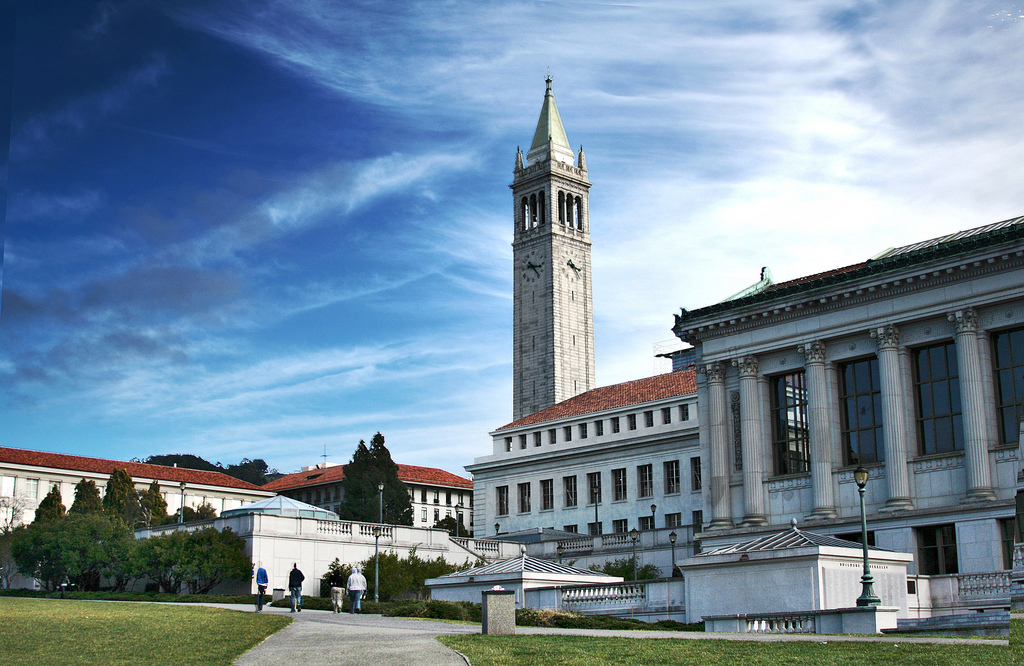
Established in 1868 as the University of California, resulting from the merger of the private College of California and the public Agricultural, Mining and Mechanical Arts College in Oakland, Berkeley offers approximately 350 undergraduate and graduate degree programs in a wide range of disciplines. The Dwinelle Bill of March 5, 1868 (California Assembly Bill No. 583) stated that the "University shall have for its design, to provide instruction and thorough and complete education in all departments of science, literature and art, industrial and profession[al] pursuits, and general education, and also special courses of instruction in preparation for the professions". In the 1960s, Berkeley was particularly noted for the Free Speech Movement as well as the Anti-Vietnam War Movement led by its students.
Berkeley is one of the 14 founding members of the Association of American Universities and continues to have very high research activity, with $789 million in R&D expenditures in the fiscal year ending June 30, 2015. It also co-manages three United States Department of Energy National Laboratories -- Lawrence Berkeley National Laboratory, Lawrence Livermore National Laboratory and Los Alamos National Laboratory -- and is home to many world-renowned research institutes, including the Mathematical Sciences Research Institute and the Space Sciences Laboratory. Through its partner institution University of California, San Francisco (UCSF), Berkeley also offers a joint medical program at the UCSF Medical Center, the top hospital in California, which is also part of the UC system.
University of California, Los Angeles
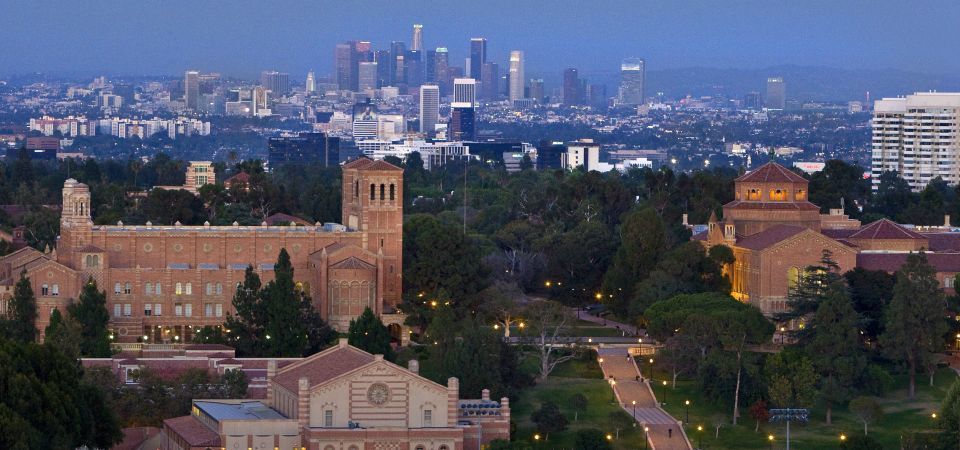
The University of California, Los Angeles (UCLA) is a public research university in the Westwood district of Los Angeles, United States. It became the Southern Branch of the University of California in 1919, making it the second-oldest undergraduate campus of the ten-campus University of California system. It offers 337 undergraduate and graduate degree programs in a wide range of disciplines. UCLA enrolls about 31,000 undergraduate and 13,000 graduate students, and had 119,000 applicants for Fall 2016, including transfer applicants, the most applicants for any American university.
The university is organized into six undergraduate colleges, seven professional schools, and four professional health science schools. The undergraduate colleges are the College of Letters and Science; Henry Samueli School of Engineering and Applied Science (HSSEAS); School of the Arts and Architecture; Herb Alpert School of Music; School of Theater, Film and Television; and School of Nursing..
University of Colorado Boulder

The University of Colorado Boulder (commonly referred to as CU or Colorado) is a public research university located in Boulder, Colorado, United States. It is the flagship university of the University of Colorado system and was founded five months before Colorado was admitted to the Union in 1876.
In 2015, the university comprised nine colleges and schools and offered over 150 academic programs and enrolled almost 17,000 students. Twelve Nobel Laureates, nine MacArthur Fellows, and 20 astronauts have been affiliated with CU Boulder as students, researchers, or faculty members in its history. The university received nearly $454 million in sponsored research in 2010 to fund programs like the Laboratory for Atmospheric and Space Physics, and JILA.
The Colorado Buffaloes compete in 17 varsity sports and are members of the NCAA Division I Pac-12 Conference. The Buffaloes have won 28 national championships: 20 in skiing, seven total in men's and women's cross country, and one in football. Approximately 900 students participate in 34 intercollegiate club sports annually as well.
University of Oregon

The University of Oregon (also referred to as UO, U of O or Oregon) is a public flagship research university in Eugene, Oregon. Founded in 1876, the institution's 295-acre campus is situated along the Willamette River. Since July 2014, UO has been governed by the Board of Trustees of the University of Oregon. The university has a Carnegie Classification of "highest research activity" and has 19 research centers and institutes. UO was admitted to the Association of American Universities in 1969.
The University of Oregon is organized into five colleges (Arts and Sciences, Business, Design, Education, and Honors) and seven professional schools (Accounting, Architecture and Environment, Art and Design, Journalism and Communication, Law, Music and Dance, and Planning, Public Policy and Management) and a graduate school. Furthermore, UO offers 316 undergraduate and graduate degree programs. The majority of academic programs operate on the 10 week Quarter System.
Oregon State University
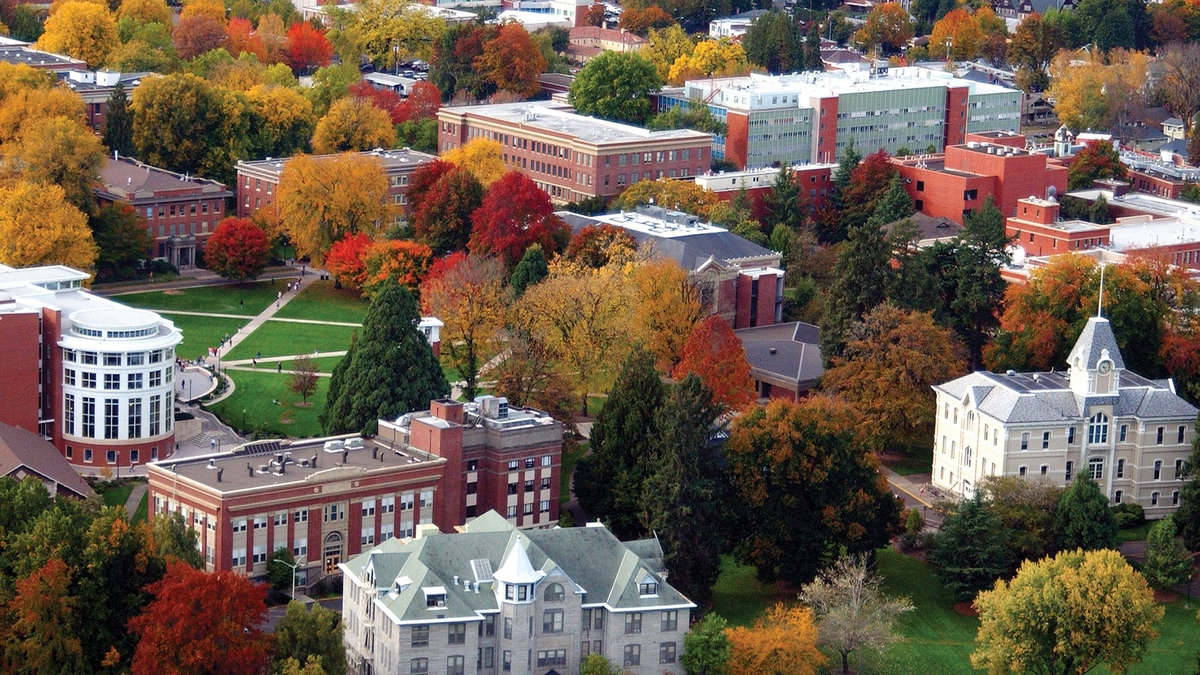
Oregon State University (OSU) is a coeducational, public research university in the northwest United States, located in Corvallis, Oregon. The university offers more than 200 undergraduate degree programs along with a variety of graduate and doctoral degrees. It is also the largest university in the state, with a total enrollment exceeding 28,000. More than 230,000 people have graduated from OSU since its founding. The Carnegie Foundation designates Oregon State University as a "Community Engagement" university and classifies it as a doctoral university with a status of "Highest research activity". This same designation is shared by 114 other top U.S. academic institutions.
OSU is one of 73 land-grant universities in the United States. The school is also a sea-grant, space-grant, and sun-grant institution, making it one of only three U.S. institutions to obtain all four designations and one of two public universities to do so (Cornell and Penn State are the only others with similar designation. Penn State is the only public university with matching designations). OSU received $441 million in research funding for the 2017 fiscal year.
University of Southern California
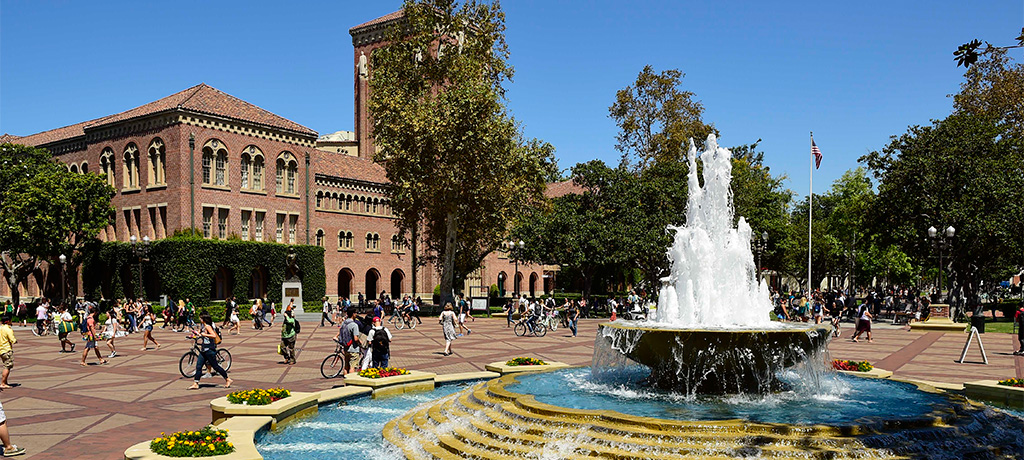
The University of Southern California (USC[a] or SC) is a private research university located in Los Angeles, California. Founded in 1880, it is the oldest private research university in California. USC has historically educated a large number of the region's business leaders and professionals. The university has also leveraged its location in Los Angeles to establish relationships with research and cultural institutions throughout Asia and the Pacific Rim. An engine for economic activity, USC contributes US$8 billion annually to the economy of the Los Angeles metropolitan area and California.
For the 2014–15 academic year, there were 18,740 students enrolled in four-year undergraduate programs. USC also has 23,729 graduate and professional students in a number of different programs, including business, law, engineering, social work, and medicine. The university is one of the top fundraising institutions in the world, consistently ranking among the top three in external contributions and alumni giving rates.
USC maintains a strong tradition of innovation and entrepreneurship, with alumni having founded companies such as Lucasfilm, Myspace, Salesforce.com, Intuit, Qualcomm, Box, Tinder, and Riot Games. As of 2014, the university has produced the fourth largest number of billionaire alumni out of all undergraduate institutions in the world.
Stanford University

The university was founded in 1885 by Leland and Jane Stanford in memory of their only child, Leland Stanford Jr., who had died of typhoid fever at age 15 the previous year. Stanford was a former Governor of California and U.S. Senator; he made his fortune as a railroad tycoon. The school admitted its first students on October 1, 1891, as a coeducational and non-denominational institution.
The university is organized around three traditional schools consisting of 40 academic departments at the undergraduate and graduate level and four professional schools that focus on graduate programs in Law, Medicine, Education and Business. Stanford's undergraduate program is one of the top three most selective in the United States. Students compete in 36 varsity sports, and the university is one of two private institutions in the Division I FBS Pac-12 Conference. It has gained 115 NCAA team championships, the most for a university (one more than UCLA), 483 individual championships, and has won the NACDA Directors' Cup for 23 consecutive years, beginning in 1994–1995. In addition, Stanford students and alumni have won 270 Olympic medals including 139 gold medals.
University of Utah

The University of Utah (also referred to as the U, U of U, or Utah) is a public coeducational space-grant research university in Salt Lake City, Utah, United States. As the state's flagship university, the university offers more than 100 undergraduate majors and more than 92 graduate degree programs. The university is classified in the highest ranking: "R-1: Doctoral Universities – Highest Research Activity" by the Carnegie Classification of Institutions of Higher Education. The Carnegie Classification also considers the university as "selective", which is its second most selective admissions category. Graduate studies include the S.J. Quinney College of Law and the School of Medicine, Utah's only medical school. As of Fall 2015, there are 23,909 undergraduate students and 7,764 graduate students, for an enrollment total of 31,673.
The university was established in 1850 as the University of Deseret by the General Assembly of the provisional State of Deseret, making it Utah's oldest institution of higher education. It received its current name in 1892, four years before Utah attained statehood, and moved to its current location in 1900.
University of Washington

The University of Washington (commonly referred to as UW, simply Washington, or informally U-Dub) is a public research university located in Seattle, Washington. Founded in 1861, it is the flagship institution of the six public universities in Washington and one of the oldest universities on the West Coast of the United States.
Established in downtown Seattle a decade after the city's founding, the university was created to aid in the economic development and urbanization of Seattle. Its two other campuses are located in Tacoma and Bothell. Overall, UW encompasses 500 buildings and over 20 million gross square footage of space, including one of the largest library systems in the world with over 26 university libraries, the UW Tower office building, art centers, museums, lecture halls, laboratories, sport stadiums and conference centers. The University offers bachelor's, master's and doctoral degrees through its 140 departments, organized into various colleges and schools. With a total student enrollment of about 46,000, UW is one of the largest universities in the United States.